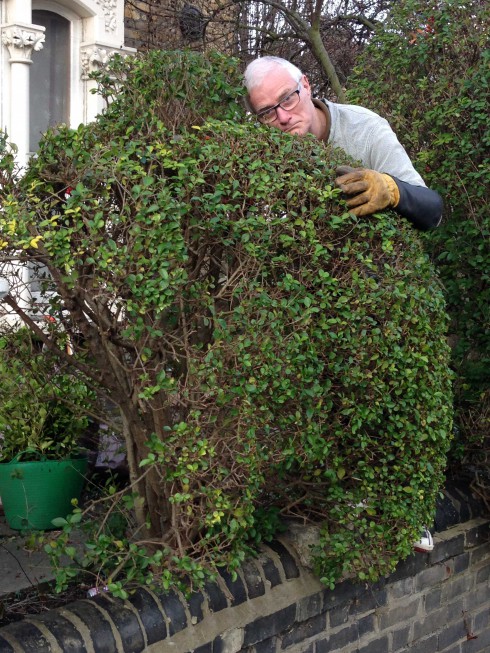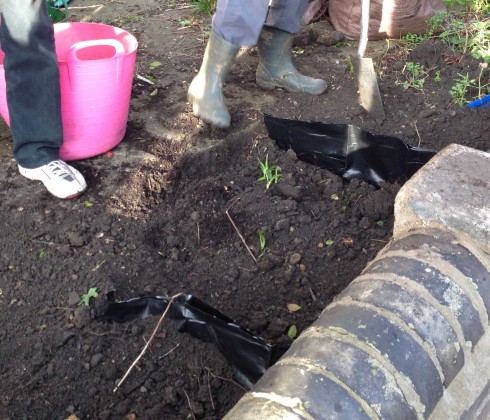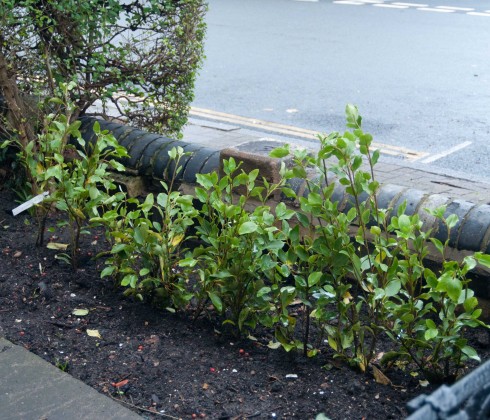 Here’s Tim. Topiary Tim. He’s looking a bit sad.
Here’s Tim. Topiary Tim. He’s looking a bit sad.
One of our elephants has had to go.
 Up until the end of last year, all was looking well in the herd. But then, fairly swiftly, telltale signs of honey fungus were spotted. There was dieback on the trunk and ears of the baby elephant.
Up until the end of last year, all was looking well in the herd. But then, fairly swiftly, telltale signs of honey fungus were spotted. There was dieback on the trunk and ears of the baby elephant.
At first we were in a state of denial. Maybe somebody had poured some nasty chemicals on the ground or perhaps wandered past with a flame thrower? But who were we kidding. We dug up roots of the wilting/dead trunk and ears, and our worst suspicions were confirmed. White fungus was clearly visible between the bark and wood.
Unfortunately, there is no cure for Honey Fungus. On the RHS website it says, ‘the only effective remedy is to excavate and destroy, by burning or landfill, all of the infected root and stump material. This will destroy the food base on which the rhizomorphs (brown root-like cords) feed and they are unable to grow in the soil when detached from infected material.’
 So all of the baby elephant has had to be destroyed. Sad, but pragmatic. We’ve dug out as much stump and roots as we could get to, not just the obviously infected wood, but also the rest of the plants which made up the baby elephant (which luckily looked untouched by the fungus).
So all of the baby elephant has had to be destroyed. Sad, but pragmatic. We’ve dug out as much stump and roots as we could get to, not just the obviously infected wood, but also the rest of the plants which made up the baby elephant (which luckily looked untouched by the fungus).

As a belt and braces approach, we’ve also added a couple of pond liner barriers to roughly 18inches deep as this should block any remaining rhizomorphs, which look like bootlaces apparently. We haven’t noticed any of these, but they could easily be confused with roots. I’ve also checked with the RHS about removing the soil around the affected area and they say that the soil doesn’t have to be removed. Hugely relieved as this could be a mammoth (ha, ha) task, but we’ve added plenty of rich garden compost for the new plants.

It would be unwise to plant privet again, as it is so susceptible to Honey Fungus, so we checked with the RHS list on which evergreens are less likely to be affected. Tim’s plumped for some (fast growing) Griselenia littoralis. This has much bigger and brighter green leaves than the privet, but should be an interesting addition to our topiary hedge.

We also plan on giving the rest of the herd a good old feed and mulch come spring, so that the elephants are fighting fit for the years ahead. Here’s hoping we’ve caught the fungus in time….
P.s. Here’s how our elephants were created by Tim Bushe (aka Topiary Tim and @hedgecutterman) in one of our neighbour’s front gardens back in 2012.


Fingers crossed for you!
Thanks Marian!
Oh my God! The elephants are fantastic! Had no idea! But great shame about the loss
Hi Ian, a great shame, but hopefully not too late for the others……
What a shame. I’d no idea that privet (which I hate, in all other forms than Tim’s sculptures) was vulnerable to honey fungus. There’s so much of the dratted stuff around – I grew up in an area where every house for streets around had a huge privet hedge and unwittingly settled in a street with far too many of them – that I’d assumed it was more or less unkillable.
Scope for more interesting hedging plants is very welcome, though – and not just dratted box, which is boringly prevalent nowadays. I saw some really clever hedging ideas last spring, including chaenomeles mixed with forsythia and a choisya hedge.
The latest unimaginative hedging fashion to spread around our area appears to be another boring one: Portuguese laurel. Dense and over-tall, it provides far too much cover for burglars to attack front windows; the police remind us of that regularly but aspirational home-owners evidently prefer appearance to security.
Hi Diana, yes, our original remit when creating the elephants was to have a much more see through hedge to discourage any anti social behaviour. It seems to have worked, plus we have such a gorgeous piece of public art.
Chaenomeles mixed with forsythia sound gorgeous.
Your elephants are fabulous – what a brilliant idea. Sorry about the baby one, though. I remember my RHS lecturer going on about honey fungus as though it was the spawn of the devil. Sounds as though you’ve done all you can to prevent it spreading. Good idea to change to Griselinia.
Hi Sam, when I spoke to the RHS they said that Wisley was riddled with it, but they still manage very well, so not to be too discouraged. Looking forward to seeing how fast growing that Griselinia is!
I think the griselinia will look great, but what a herculean task. After your last newsletter I tried to leave a note about the nursery you mentioned: EDULIS. I have bought a few plants from them, at plant fairs. recommended for woodland gardens, but none survived. For some reason I could not post it.
Hi Susan, sorry you couldn’t ;eave a comment. Still seem to be comments coming through on that page though. Thanks for letting me know about your Edulis plants. Will keep an eye on mine next year.
Brilliant elephants. Sorry for the loss of the baby one.
Thanks FD. Hopefully new baby one will grow up nice and quick!
This is so sad. The amount of love that went into the elephants. But I always say it is a planting opportunity when something dies in my garden.
Hi Lisa, quite right. Neither Tim or I have experimented with Griselinia for topiary before, so excited to see how it grows and how new forms are created from it.
What a brilliant idea for a hedge. Sorry about the fungus,but hopefully you will have caught it in time
Hi Annette, the only other time I had to deal in a big way with Honey Fungus was when it had devastated 18m of privet hedging. Really hoping we have spotted it in time this time round….
I have heard about this on other blogs, but I think I had better look it up so I can spot it. Good luck this time.
Quality post! Such sadness and hard work….
Hi Sarah, a little sad, but as Lisa pointed out (above), always a new planting opportunity! Definitely worth the hard work.
Your elephants are lovely! So sorry about the honey fungus, but at least the parents won’t be childless forever, with your new planting. Tough to remove something that you must have nurtured for a while, but sounds like you took the right course. Best of luck with grizelinia, and thanks for sharing. Part of the battle is identifying these sorts of fungal problems asap, and then being thorough and scrupulous in dealing with them…
Hi Jo, luckily had seen this dieback before when Honey Fungus had really set in on a large privet hedge, so knew the best (and only) option was quick action.
Looking forward to seeing how we get on with the Griselinia.
Sorry about the loss of that handsome baby elephant. But I’ve got one question – is this at your personal home, a client, or a business? They are just amazing. 🙂
Hi Judy, The elephants are on my road in the garden of one of our neighbours. Originally it was an overgrown privet hedge on a corner which bad things were happening behind. Once we were aware of Tim’s topiary talents in our midst, we enlisted him to transform the hedge to something more beautiful (and a little more see through.) They are now a very loved part of our community.
What a wonderful community project. It must make you smile every time you go by it. Here’s to the growth of a happy new baby elephant. 🙂
Reblogged this on Old School Garden.
Thanks Nigel!
Gorgeous elephants! Good work and best of luck for the new addition!
Thanks Cat. Looking forward to seeing how Tim can work with the Griselinia.
Ah what a shame, they were so spectacular. Lets hope that the other ones don’t get affected. Will keep fingers crossed.
Hi Annie, Luckily still looking fairly spectacular as it’s only the baby at the end of the herd that’s down. Fingers crossed indeed!
Such an amazing gardening spectacle, hopefully everything stays well!
Thanks NI, FIngers crossed!!
Pretty impressive at any rate. Atleast you still have the big one. How long have you had the big one?
Hi PL, the herd was created at the beginning of 2012 from a very overgrown privet hedge. Here’s hoping they’ll be with us for years to come….